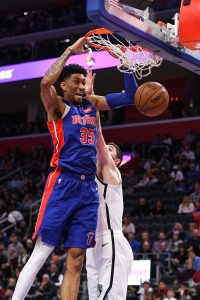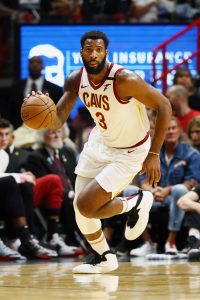Although some NBA teams can become hard-capped during a given league year if they use specific exceptions or make certain transactions, the NBA doesn’t have a set hard cap for all teams. In addition to its soft cap though, the league does have a luxury tax threshold, which serves to discourage excessive spending. When a team’s total salary ends up over that line at season’s end, the NBA charges a tax for every extra dollar the club spends.
[RELATED: Recent History of NBA Taxpaying Teams]
The formula to determine the luxury tax line is a complicated one, related to the NBA’s projected basketball related income (BRI) and projected benefits. Generally though, it comes in around 20-22% above the salary cap line. For instance, in 2019/20, the league’s salary cap is set at $109,140,000, while the luxury tax threshold is at $132,627,000. So any team whose total ’19/20 salary exceeds $132,627,000 on the last day of the regular season is subject to a tax bill.
The NBA’s luxury tax system is set up so that the penalties become more punitive if teams go further beyond the tax line. Here’s what those penalties look like:
- $0-5MM above tax line: $1.50 per dollar (up to $7.5MM).
- $5-10MM above tax line: $1.75 per dollar (up to $8.75MM).
- $10-15MM above tax line: $2.50 per dollar (up to $12.5MM).
- $15-20MM above tax line: $3.25 per dollar (up to $16.25MM).
- For every additional $5MM above tax line beyond $20MM, rates increase by $0.50 per dollar.
- Note: This would mean $3.75 for $20-25MM, $4.25 for $25-30MM, etc.
For instance, if a team is over the tax by $12MM, its tax bill would be $21.25MM: $7.5MM for the first $5MM over the tax, $8.75MM for the $5-10MM bracket, then $5MM for the final increment in the $10-15MM bracket.
While those are the rates that apply to most taxpayers, including the Trail Blazers, Heat, and Timberwolves this season, a team can become subject to a “repeater” penalty if it paid the tax in three of the previous four seasons. This scenario currently applies to Oklahoma City — the Thunder were a taxpaying club in 2016, 2018, and 2019, which means they’ll be a repeat offender this season. Here are the penalties that apply to repeat taxpayers:
- $0-5MM above tax line: $2.50 per dollar (up to $12.5MM).
- $5-10MM above tax line: $2.75 per dollar (up to $13.75MM).
- $10-15MM above tax line: $3.50 per dollar (up to $17.5MM).
- $15-20MM above tax line: $4.25 per dollar (up to $21.25MM).
- For every additional $5MM above tax line beyond $20MM, rates increase by $0.50 per dollar
- Note: This would mean $4.75 for $20-25MM, $5.25 for $25-30MM, etc.
If the hypothetical team we described in our first example, over the tax by $12MM, was a repeat taxpayer, its bill would increase to $33.25MM.
Generally speaking, luxury tax penalties are calculated by determining a team’s total cap hits at the end of the regular season. So a team that starts the year above the tax line could get under it before the end of the season by completing trades or buyouts. The Warriors did just that in February, slipping below the luxury tax threshold by completing a series of trades that reduced their overall team salary.
[RELATED: Projected Taxpaying Teams For 2019/20]
However, team salary for tax purposes is calculated slightly differently than it is for cap purposes. Here are a few of the adjustments made at season’s end before a team’s tax bill is calculated:
- Cap holds and exceptions are ignored.
- “Likely” bonuses that weren’t earned are removed from team salary; “unlikely” bonuses that were earned are added to team salary.
- If a player with a trade bonus is acquired after the final regular season game, that trade bonus is added to team salary.
- If a player with 0-1 years of NBA experience signed a minimum-salary free agent contract, the minimum-salary cap charge for a two-year veteran is used in place of that player’s cap charge.
- Note: This only applies to free agents, not drafted players. For example, Raptors rookies Dewan Hernandez (second-round pick) and Terence Davis (UDFA) are each earning $898,310 in 2019/20. Hernandez would count for $898,310 for tax purposes, while Davis would count for $1,620,564.
So let’s say that five teams finish the season owing a total of $50MM in taxes. Where does that money go? Currently, the NBA splits it 50/50 — half of it is used for “league purposes,” while the other half is distributed to non-taxpaying teams in equal shares. In that scenario, the 25 non-taxpaying teams would receive $1MM apiece.
As cap expert Larry Coon explains in his CBA FAQ, “league purposes” essentially covers any purpose the NBA deems appropriate, including giving the money back to teams. In recent years, the NBA has used that money as a funding source for its revenue sharing program. Coon also notes that the CBA technically allows up to 50% of tax money to be distributed to non-taxpaying teams, but there’s no obligation for that to happen — in other words, the NBA could decide to use 100% of the tax money for “league purposes.”
Note: This is a Hoops Rumors Glossary entry. Our glossary posts will explain specific rules relating to trades, free agency, or other aspects of the NBA’s Collective Bargaining Agreement. Larry Coon’s Salary Cap FAQ was used in the creation of this post.
Earlier versions of this post was published in 2012 and 2018.

 He changes teams via trade. For instance, the Cavaliers would hold
He changes teams via trade. For instance, the Cavaliers would hold